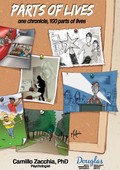It was my second week of ninth grade (now known as secondary-III) when I overheard a kid in a sports jacket and dress pants glare at another kid and say, “I’d beat you up, but I have my good stuff on.”
Good stuff? What kind of ninth grader dresses up like John Travolta’s Tony Monero? In my time you NEVER dressed up except on “picture” day – and then only if your Mom made you!
This got me thinking about behaviour changes as we enter high school. We start to act as a function of what others will think instead of doing the things that we actually feel like doing. In my first week of high school I vividly remember seeing a kid puffing on a cigarette while trying hard not to choke. I also remember how during the previous summer he told me how disgusting he thought cigarettes were.
I think that the transition to adolescence is challenging for kids because of this emerging concern over what others are thinking and of how we appear to them. Researchers call it a “theory of mind (ToM),” - the ability to understand that others may have thoughts and feelings that are distinct from our own. Since thousands of teens and pre-teens across the city are starting a new school year, I decided to explore the implications of the theory of mind on the nature of the anxieties that school kids live with in my September 1st column for Métro (see below).
What is particularly interesting about the concept of a theory of mind is that it is believed that children with autism lack the ability to develop one. The same is likely the case in individuals with Asperger’s syndrome. Asperger’s syndrome is similar to autism but with fully developed language skills. Because young kids have not developed a ToM, those with Asperger’s syndrome do not appear very different from their classmates. Language develops normally. It is only as they become adolescents that the deficits become apparent. They lack the ability to detect social cues or the ability to put themselves in the mind of another. I once assessed a teenager with Asperger’s syndrome. He would often stand on the school cafeteria’s tables and, for a quarter, act like any animal he was asked to. Now I’m sure there are others who would have done the same but this person was completely unaware that he was being laughed “at” rather than laughed “with.” Because of their inability to evaluate normal social cues, many may mistakenly feel they have a girlfriend or boyfriend. In such cases, it is not uncommon to hear that a restraining order was taken out against them.
The development of a theory of mind in adolescents is what makes high schoolers so hyper-aware of what others think and concerned with the social image they project. This is why social anxiety is so common in this age group.
By the way, you may be interested to know that one of the world’s leading experts in Autism and the Theory of Mind is a Cambridge Professor named Simon Baron-Cohen. You might be more familiar with his brother Sacha…of Borat fame!
The Baron-Cohen bros.
IN THE MIND OF MINORS
(Source: Dans l’esprit des jeunes. Journal Métro, September 1, 2009)
“Miss, how come you have hair on your face like a man?” said the six-year old to his teacher.
Did you ever notice how young children think? They are completely in their own little bubbles. The question above was a real one overheard at a local elementary school. Such embarrassing questions constantly come from the mouths of younger children. They are simply trying to make sense of the world and have no idea yet about what is, and what is not, proper to say.
The mind of the elementary school kid
In elementary school, most pre-adolescents do not have the maturity yet to think like another person or to imagine what another person would think or feel. They might tell someone on the bus, “Look at my new shoes!” without realizing that the fellow passenger couldn’t care less. This is because younger children have yet to develop a theory of mind.
Theory of mind refers to the ability to understand that others may have thoughts and feelings that are distinct from our own. When six-year olds point out physical flaws, they have no idea that this might hurt people. They are simply responding to their own curiosity.
This is why children can be so cruel to classmates who are different. They will point to, or laugh at, physical or psychological differences simply because they stand out. They are blind to the feelings aroused in others because they do not have a theory of mind.
The mind of a high-schooler
High-school aged students are quite different. By that time, most of them have developed a theory of mind. This makes them aware of the image they project and they become quite concerned with what others think. This is why many of them develop social anxieties and can often feel out of place.
This newly developed awareness of who they are in the minds of others is what makes adolescents try to conform to their peer groups and what makes them so vulnerable to negative influences such as smoking or drugs.
Being different. Feeling different.
The development of a theory of mind will affect the nature of social anxieties that children experience and determine how they fit in with their peers. Since they are surrounded by kids who have yet to develop a theory of mind, elementary school kids will get along well with their classmates and won’t get picked on just so long as they ARE not different. High schoolers, on the other hand, have usually developed such a theory and are acutely aware of what others think. They get along well with their peers just so long as they do not FEEL different.
Tagged as Asperger's syndrome, Autism, Simon Baron-Cohen, Social anxiety, Theory of mind.
Posted in Anxiety.
Posted on 13 Sep 2009



